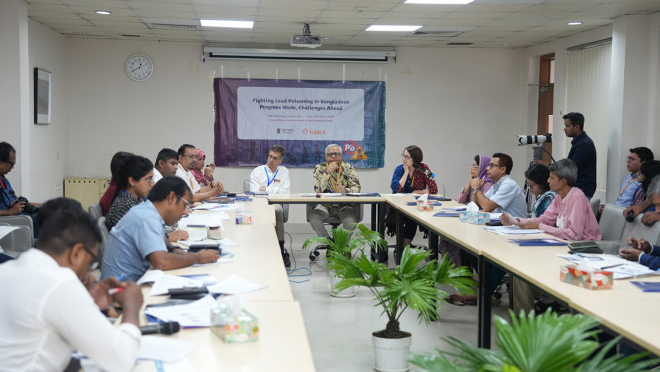Study shows 98% of children in Dhaka suffer from lead poisoning risk
Study shows 98% of children in Dhaka suffer from lead poisoning risk

A shocking 98% of children in Dhaka have excessive levels of lead in their blood, raising serious public health concerns, according to a study by the International Centre for Diarrhoeal Disease Research, Bangladesh (icddr,b).
The children’s blood lead levels significantly exceeded the reference threshold of 35 micrograms per litre set by the US Centres for Disease Control and Prevention (CDC), with a median level recorded at 67 µg/L, it said.
Children living in the Dhaka South City Corporation area showed higher levels of lead, likely due to the concentration of battery manufacturing and recycling plants in that zone, the study added.
Dr Jesmin Sultana, assistant scientist of icddr’b, revealed the findings at an event titled “Lead Poisoning in Bangladesh – Progress Made, Challenges Ahead”, held at the icddr,b today (6 August). The study included 500 children aged between 2 and 4 years in Dhaka between 2022 and 2024.
The study found that children living within 1 kilometre of lead-based industrial sites had 5 micrograms more lead per kilogramme of body weight in their blood—40% higher than children living further than 5 km away.
Other sources of lead exposure include household dust, lead-containing cosmetics, and cooking utensils, Dr Jesmin said.
According to Unicef, Bangladesh is now the 4th most lead-impacted country globally, with 36 million children suffering from elevated blood lead levels.
Research presented at the event revealed that in Dhaka slums from 2009–2012, 87% of children under 2 had blood lead levels >50 μg/L, strongly associated with stunting.
Steve Luby, professor of Medicine at Stanford University and a former Director at icddr,b, highlighted how lead exposure severely impairs brain development, causing IQ loss and cognitive deficits that can permanently affect future generations.
He said, “Lead enters the body in multiple ways, through the air we breathe, the food we eat, contact with contaminated soil or dust, and even during pregnancy through the placenta. These exposure pathways make it nearly impossible to avoid unless we address the root causes in our environment.
Impact of lead on a child’s body
Damage to the central nervous system, learning disabilities, lower IQ, behavioural problems, hearing loss, decreased bone and muscle growth, kidney damage, anaemia.
Tahmeed Ahmed, executive director of icddr,b, emphasised the stakes: “Lead poisoning silently damages children’s brain development and nutrition. We must act decisively to eliminate these sources of exposure so that every child can grow up healthy, smart, and ready to contribute to our nation.”
How to protect children
Health experts have urged immediate action to shut down or strictly regulate industrial sites in Dhaka that are releasing toxic lead, warning that these sources pose a severe health risk to thousands of children.
They recommend promoting the use of lead-free batteries—such as Nickel-Zinc, Lithium-ion, and other environmentally friendly technologies—as a safer alternative. The use of lead-free products, including paint, cookware, jewellery, surma, and amulets, should be widely encouraged.
Experts also advise reducing cigarette smoking, particularly indoors, and regularly wet-mopping household areas to minimise exposure to lead-contaminated dust.
Good examples
Md Mahbubur Rahman, project coordinator at icddr,b, presented findings from a decade of lead-related research. One of the most impactful interventions to date has been targeting turmeric adulteration.
Following the study findings, the Bangladesh Food Safety Authority took measures, including public awareness campaigns, stricter enforcement, and regulatory actions. As a result, the proportion of lead-contaminated turmeric samples dropped significantly—from 47% in 2019 to virtually none by 2021.


